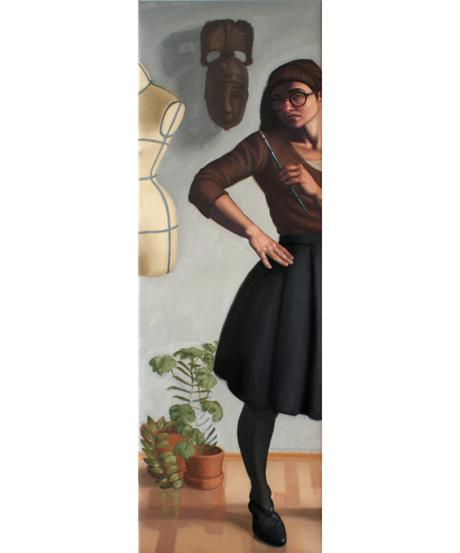
Divided (c) Samantha Groenestyn
The painter practices a shadowy art: one of flimsy surfaces imbued with illusory depth, one of treacherous likenesses, one of unbounded profusion that disrupts the rigorous order imposed by the rational mind, one of quivering movement that breaks the quietude of the soul. But this is only within the carefully demarcated world of representation, built upon the long-entrenched prejudices of Platonism. The world of representation infers models for every copy; it assumes every image to be in a degraded relation of dependency upon some unwavering truth (Deleuze, 1990 [1969]: 259). Being visible, painting may only approximate truth. It must imperfectly mimic truth, offering us merely a plausible rendition (Plato, Tim., 28a; 29b). Painting proliferates wildly, disgorging as many iterations of truth as there are viewpoints at every conceivable time. Painting boils over with the feverish richness of experience, actualising every basic human truth–love, longing, loss, contentedness–in every different shade and hue. Painting challenges the impulse to declare truth abstract and constant. Each life might be reduced to the same few categories, but the art is in the living, in the particular threads we weave. The painter who escapes the arena of representation makes a claim for the positive power of the image, shedding the conception of the image as imitation. She attempts to ‘reverse Platonism’ (Deleuze, 1990: 253; 262).
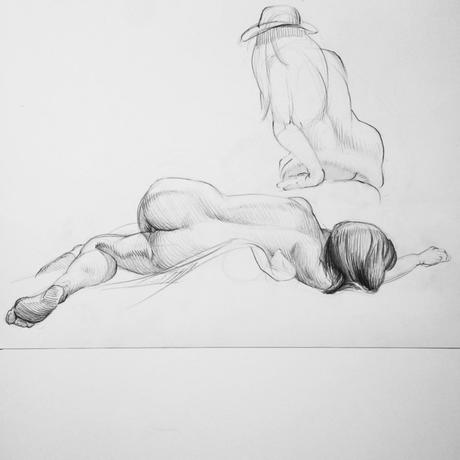
I
Representation is founded on a false relation. It draws a connection between a painting and the world, suggesting that the painting, like a word, stands in for something in the world–something which thus must be more real. The relation is unequal, for the world does not refer to the painting. Better yet, says representation, the painting–like a word–might stand in for something far more abstract, something not even visible in the world. By an elaborate chain of substitution, a painting is first divided into color and drawing, and by means of drawing it is dismembered into figures and ground: a figure is selected and cut out by line, peeled out of its context and raised up as a sign; that sign, now sharply recognisable, can shed its visual form for a word, a word which refers to an object in the world which in turn is but a metaphor for a deeper idea. This is to say: representation denies a painting its own status. It places it at the end of a long series of imperfect replacements for verbal thought. The original assumption behind representation is that thought is necessarily abstract and invisible, but that to trade thoughts with one another we must dress them up in inadequate clothing.
To challenge this assumption is to assert other modes of thought. It is to suggest that the painting, as it is, in its entirety, is complete; that it may be confronted on its own terms, not greeted as a carrier of other messages. This would break down Art as we have come to know it: tour guides, artist statements and historical notes would prove incidental. Painters would not calculate their strokes according to verbal ideas, nor would they translate their technically weak paintings back into words that explain them. It is only representation that demands explanation, that drives the impulse to understand. Explanation and understanding pursue the referents at the expense of their disposable carriers. Once the truths buried in the painting are uncovered, the skin that is the painting may be cast aside.
But the painting may not be cast aside as a skin. If this were the case, any skin would do: any covering would only imperfectly approximate that buried truth, and many coverings could be reduced to that single truth. Wittgenstein (1966: 36) holds up the stubbornness of the particular and the mad repetition it induces–not just any minuet will do; not just any Mary, not just any Nordic sea. It is this one that resonates with me in this moment, it is this one I return to again and again. The idea is not enough; what moves me is precisely this manifestation in all its particularity.

II
We begin, with Deleuze (1990: 7), to return to the surface, accepting its limitless possibility. We confront the flatness of the painting and we do not demand depth of it, layered meanings, or buried truths. We do not dissect it, because such holes would deflate this thing that hovers before us as a unity, carefully interwoven, every stroke balanced against every other. We turn from our analysis and begin to affirm, with Lucretius (DRN IV), the multiple, the positivity of the infinite, the world itself (Deleuze, 1990: 279). The world mirrors the abundance of the picture plane, and its surface–across which the particularities of experience spread–offers us its most profound truths. Where we search for patterns, we find exceptions; where we impose laws, we must amend them to cope with variables. The world’s movements are subtle and fluid, and our explanations are clunky. But where our minds struggle to describe with precision, our bodies adapt to the rhythms of the world with remarkable dexterity (Merleau-Ponty, 2012 [1945]: 171-172). The search for depth confounds us; the direct contact reassures us.
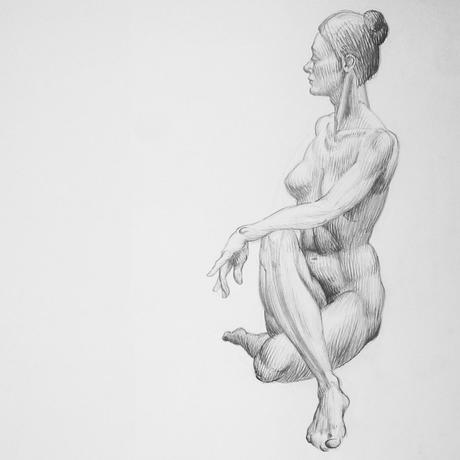
III
Plato’s (Tim., 27c; 29b) old dichotomy haunts philosophy of art; we still divide the world into being and becoming and we trust the one more than the other. We set them as our standards for knowledge, and we condemn the painter along with the Sophist. For the ‘image’ is not simply a picture; in our tradition it has an enduring status as an imitation, as a copy of a model (Plato, Tim., 29b). It stands as the original mold of representation, since it necessarily clings to its referent. An image might be a picture, but it might be anything sensory–as Augustine’s (2009: 152; 172) vast palaces of the memory, catalogues of images gathered through all sensory channels, make clear. Whatever sensory mode it takes, ‘the image … is an ever-moving apparition of something else’ (Plato, Tim., 52c).
Plato (Tim., 29b) casts the image under the banner of becoming, which he considers an imperfect copy of eternal being. And the nature of becoming is that it is restless. It is always in transit, and never arriving. It is not height, but shrinking or growing, and each implies the other, because becoming is the possibility of all movement, it is the pull of opposing possibilities at once. ‘Alice does not grow without shrinking’ because becoming is the relation between what has been and what will be (Deleuze, 1990: 1). Becoming admits that the world consists in these comparisons; it admits how readily we slide between them as we shift our position or traverse time. Becoming encapsulates the surge towards but never the goal. Time itself, the very condition of movement and change, is the image of eternity (Plato, Tim., 37d). The instability it introduces into the world is the direct result of its status as a flawed copy of a perfect model. Indeed, the world itself, being visible, being encountered via the senses, is on Plato’s (Tim., 28b-29b) terms merely an image.
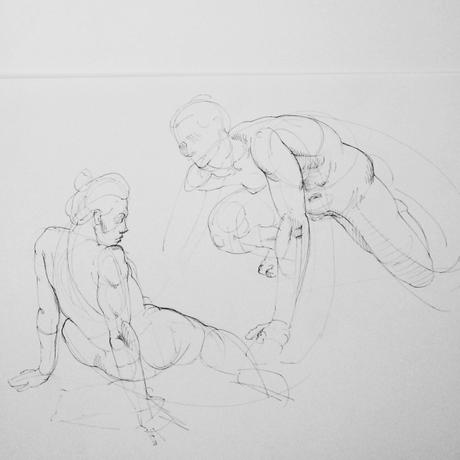
IV
It is not, then, that Plato urges us to distrust our senses, only that the world in all its loveliness is pitched as inferior to the divine. What is mental and spiritual cannot be grasped through the senses; it is the special privilege of intellect to think abstract thoughts (Plato, Tim., 34c, 37c, 45a). As abstractions, such thoughts distill the multiplicity of the world into immovable and universal concepts, revealing the simplicity and order of the structure of the world. Rather than ‘embracements of flesh,’ abstract thought permits the ‘embracement of my inner man: where there shineth into my soul what space cannot contain, and there soundeth what time beareth not away’ (Augustine, 2009, p. 150). While Augustine’s (2009: 152-153) palaces of memory are conceived spatially, as interlocking caverns where images (and not the things themselves) are stored up inside of us, abstract thoughts escape this spatial constraint. These purely intellectual products of reason and number–‘the things themselves’ and not images of them–take up ghostly residence in us, in no place (Augustine, 2009: 154-155).
Movement is characteristic of the surface, while the rational stillness of being can only lie at some deep core (Plato, Tim., 57d-58a). Plato shuns movement not only because it is disruptive and uncontainable, but also because it is superficial. It corresponds to passive perception rather than deep reflection; it blithely concerns itself with unassuming exteriors rather than troubling to dig for truth. The body gives us no access to the depths and its palpitations distract us from such sober and bodiless thoughts.
And when the painter coats a swathe of linen with a thin film of pigment bound with oil, promising nothing of depth, but only a reflection of our own turbulent emotions, she seems to leer as the charming Sophist, winning our trust with superficially appealing approximations rather than honest and probing arguments. Her art is a rhetorical one: she carefully appraises the situation and adapts her picture accordingly, responding to its effect rather than holding fast to truth (Lichtenstein, 1993 [1989]: 180). Truth becomes subordinate to the effectiveness of her picture, and a picture is not effective when it accurately conveys a message to us but when it moves us. The imitative art of painting mirrors, in all its shifty superficiality, the ‘imitative art of reasoning’ (Plato, Soph., 234b-c). Aligned with becoming rather than being, the painter and the Sophist at best make plausible claims; at worst they deliberately deceive. In any case, they lay no claim on knowledge, since they refuse to excavate the truth (Plato, Tim., 29b; Rep., 510a). The imitative art of painting and the imitative art of reasoning are arts of the surface.
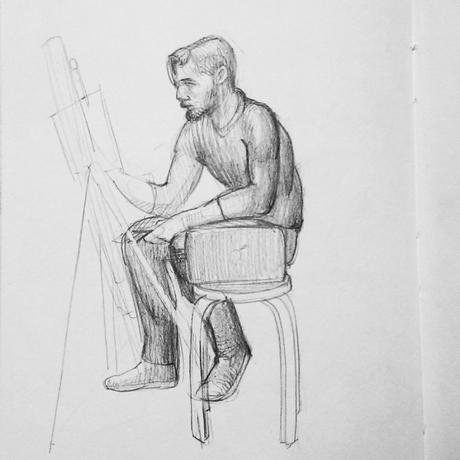
V
Yet the imitative art consists in two distinct breeds, even by Plato’s (Soph., 235d-236c) account. He considers the art of likeness-making less reproachable than the art of making appearances. The likeness strives after the inner being of the object, attempting to remain faithful to its objective proportions, while the appearance fixes on its surface and, like the painter, preserves the relations between object and observer. The maker of appearances affirms with Merleau-Ponty (2012: 77-80; 196) that there is no view from nowhere, but only perspectives: views from here or there, a shifting web of relations across a rippling and indeterminate world. The maker of appearances is the agent of becoming (Deleuze, 1990, p. 256). The painter and the Sophist don the same guise, accused by Plato (Rep., 597b-e) of standing at the third remove from reality. Their copies are not honest copies of nature, such as the carpenter might construct. With utter disregard for things ‘as they are,’ the agents of becoming dazzle us with a false knowledge which only skims the surface. Their cheap imitation is only concerned with how things appear (Plato, Rep., 598a-600e).
The echoes of this accusation of sophistry ring well into the twentieth century. The Cubist painters fret over how to paint things as they are, and renounce the ‘surface effects’ of light and perspective, the painter’s traditional tools of depth (Rivière, 1966 [1912]: 82-83; Gleizes and Metzinger, 1988 [1912]: 37-38). In a fit of irony, the Cubists scramble to portray their inner selves by trying to depict the insides of mundane objects, and this they attempt by multiplying the surfaces of those objects and consciously depriving them of depth (Rivière, 1966: 88; Gleizes and Metzinger, 1988: 46; 52). Painting approaches higher peaks of absurdity the deeper it descends. Its intellectualism retreats from the sensory, seeking the bodiless abstractions that occupy no space in Augustine’s palaces of the memory. But its method remains stubbornly physical. Painting, after all, takes up space, it gives presence to thoughts. The Cubists encounter the limits of representation: if truth is deep, and painting remains at the surface, painting and truth are incompatible. And this is the very philosophical landscape Plato has herded us into: painting is in bondage to representation, inescapably subject to its hierarchy, by definition subordinate to it (Deleuze, 1990: 259-260).
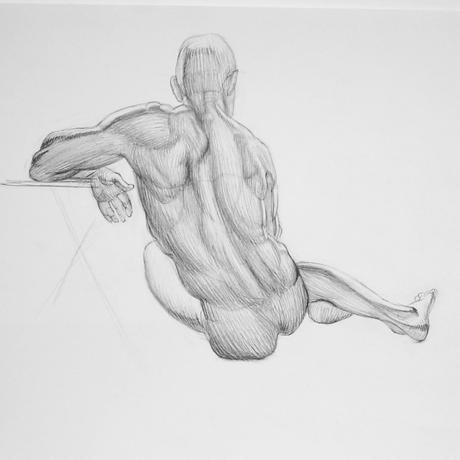
VI
By insisting on what we have called the false relation of image to world, Plato has obscured the crucial division. Distracted with distinguishing copies from models, we failed to notice that we confront two types of images (Deleuze, 1990: 256). And these are not simply the true likeness (as of the craftsman) and the deceptive appearance of the painter-Sophist. Deleuze (1990: 257) makes very plain that ‘if we say it is a copy of a copy, an infinitely degraded icon, loose resemblance, we miss the difference in nature between simulacrum and copy.’
This difference in nature lies in a fundamental difference in conception of resemblance. Resemblance may stem from an original similitude or even identity, from which it decays the further it strays from the model, as in Plato’s position. Or it may stem from a fundamental disparity (Deleuze, 1990: 261). In the case of the former, the traditional copy, an inner, spiritual, mental resemblance is imperfectly preserved. The copy makes feeble reference to the model. But in the latter, no such inner structure binds the two; they converge precisely because they are different. Plato bears down on us with the insistence that this outward similarity is a trick, trying to mimic an inner bond. But Deleuze (1990: 253) stands firm, defiant in his effort to ‘reverse Platonism.’ The simulacrum, he insists, ‘internalises a dissimilarity’ (Deleuze, 1990: 258). The way out of the trap of representation is to seize upon this inner unrest.
The inner disparity revels in the outward profusion of similitude in the world. The world is a jubilant profusion of diversity, of reckless variation and rampant growth, spawning rainforests of unimaginable beasts and vegetation whose individuals yet present their own personal traits (Deleuze, 1990: 266). Amplifying on Lucretius (DRN IV), Deleuze (1990: 266; 268) argues that this abundance presents no threat; rather, ‘nature must be thought of as the principle of the diverse and its production,’ and that principle is a limiting one. Increase and multiplication do not run along every axis. The number of kinds is not infinite, but among each kind, infinite instances may occur. Growth is not entirely unrestricted–there is method in its madness. Permitting the wild permutations of the world affirms truth of an entirely different flavour: one that aligns with our experience at the surface of the world, daily confirmed by our bodily immersion in the world.
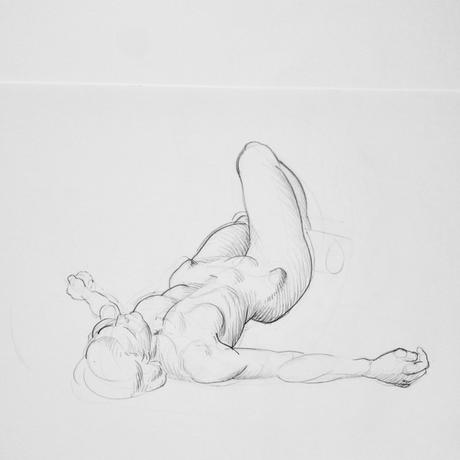
VII
The proliferation at the surface of the world cannot be described in representational terms. Each manifestation is not a deviation from a model, but it ‘speak[s] across difference’ (Foucault, 1983 [1973]: 32). The world multiplies in series, a level field of different objects without hierarchy, sitting by one another in all their distinctness. Where they resemble one another, we must understand this as the outward convergence of inwardly disparate things. Foucault (1983: 44) further refines the concept of resemblance, teasing out the inward disparity and calling it ‘similitude,’ abandoning ‘resemblance’ to representation. The visual likeness that a painting may offer appeals to similitude, to the proliferation in series like that at the surface of the world. It can move in any direction, as Alice shrinks and grows at once–for it is always becoming. It posits the ‘indefinite and reversible’ relations between cohabitant things, not the firm reference to a model (Foucault, 1983: 44). It is in this sense that it ‘refer[s] to nothing;’ it refers not to things but to fluid relations between things (Foucault, 1983: 48).
This likeness is of an entirely other kind than that for which Foucault reserves the term ‘resemblance,’ which is inescapably grounded on a model, clinging to that inner likeness (if not identity). Resemblance always returns to the model, its purpose is ever to sacrifice itself in order to reveal the model (Foucault, 1983: 44). It is the skin that sheds itself, the superficial layer that conceals, only to finally reveal, the depths. Resemblance proves to be in servitude to representation because it treats likeness as a sign. The sign is the gateway to penetrating the surface, and it ruthlessly requires substitution: ‘This thing,’ the sign proudly declares as it annihilates itself, ‘is something else’ (Foucault, 1983: 44).
And this is how, according to Foucault (1983: 53), resemblance reintroduces words into the world of shape, which actively resisted it. While painters worked wordlessly in their studios, marvelling at their own physical encounter with the surface of the world, at the golden sunlight that melted over a late afternoon in early Summer, at the shocking discord they discovered between themselves and close companions, at the dreary fog of futility that seemed to descend on a Sunday, noting all these things in their particularity and setting them down in paint from their own perspective, words were ever stalking the boundaries of likeness and waiting to seize it for deeper purposes (Foucault, 1983: 41). The painter may defer to either side, either embracing the sign or denying it. When she denies it, she reveals the depths to be empty. There was never anything to uncover, to understand or to interpret. ‘Absence reascends to the surface’ (Foucault, 1983: 41).
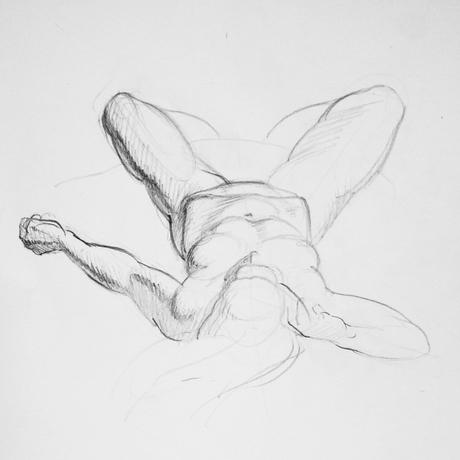
VIII
Having cleared the depths, we must now face this absence. The painting looms before us, flat and silent. Disarmed of our representational tools, we must simply confront the surface, accepting that painters do not bury treasures but simply reflect an experience of the world. That world is lavish and indeterminate, shimmering at its edges (Husserl, 1973 [1948]: 87). It offers an ever-changing array of possibilities upon which we may seize, with each act opening out into a new branch of possibilities. This openness affirms the movement of the world, the agitation of a world that is always surging towards and never arriving, a world premised only upon becoming without any deeper and constant being. The movement ripples back and forth across a surface of reversible relations, of which the painter is one small thread in a complex weave. Though her position is arbitrary, it is nevertheless her own, and she wields her brush with conviction, actualising a little corner of that world from her perspective, emphasising the relations that resonate with her, imposing the order of perspective, not of internal resemblance. Things make sense from her angle, or rather, she makes sense of them, by setting these relations into a holistic harmony with one another, a harmony of colours, tones, shapes, lines and textures. She demonstrates not what the world means, but why it matters, praising each particular.
The painter thinks in terms of Augustine’s stored up images and not in the hovering truths of number. She returns to her easel with the same recurring impressions circling in her head, reconfiguring them and reformulating them until they touch a nerve, bypassing the intellect altogether (Sylvester and Bacon, 1975: 18). What she puts forward is not a statement, but something that, when effective, also resonates with us as viewers when we linger at the surface.
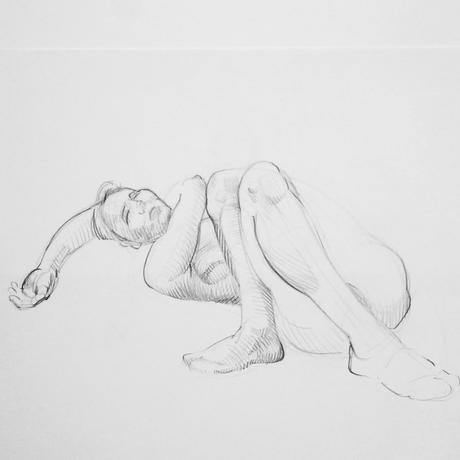
IX
The image is a tarnished concept, inextricably bound up in imitation: in the reference that copy makes to model. It binds us to the world of representation, a world in which painters are either deceitful Sophists with seductive rhetorical tricks, or in which they must disavow the surface and proclaim themselves messengers of deep truths, and try to resolve the paradox of giving spatial form to what is purely abstract. Where the image cannot be rescued, it must be replaced. We must appeal instead to the simulacrum, to similitude, to series and to surface. Painters side with the Sophist only to turn his question upon Plato (Soph. 239d): ‘Pray, what do you mean at all by an image?’ It is Plato (Soph. 239e-240a) who, ‘when you address him as though he had eyes,’ laughs in response, who ‘pretend[s] that he knows nothing of mirrors and streams, or of sight at all; [who] will say that he is talking about an idea.’ The painter wordlessly wipes back her thin film of wet paint and exposes nothing but the blank expectation of experience, of life ready to be lived.
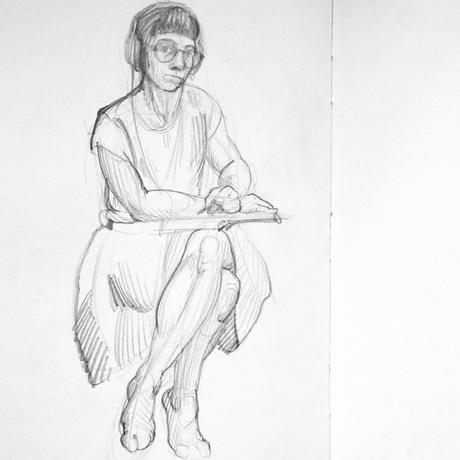
Augustine. (2009). The Confessions. Oxford: Oxford University.
Deleuze, Gilles. (1990 [1969]). The Logic of Sense. Edited by Constantin V. Boundas. Translated by Mark Lester. London: Athlone.
Foucault, Michel. (1983 [1973]). This Is Not a Pipe. Translated by James Harkness. Berkeley: University of California.
Gleizes, Albert, und Jean Metzinger. (1988 [1912]). Über den ,Kubismus.’ Übertragung von Fritz Metzinger. Frankfurt (Main): Fischer.
Husserl, Edmund. (1973 [1948]). Experience and Judgment: Investigations in a Genealogy of Logic. London: Routledge & Kegan Paul.
Lichtenstein, Jacqueline. (1993 [1989]). The Eloquence of Colour: Rhetoric and Painting in the French Classical Age. Translated by Emily McVarish. Berkeley: University of California.
Lucretius, C. T., & Bailey, C. (1948). Lucretius on the nature of things. Oxford: Clarendon Press.
Merleau-Ponty, Maurice. (2012 [1945]). Phenomenology of Perception. Hoboken: Routledge.
Plato. (1988). The Republic, 2nd edition. Translated by Desmond Lee. London: Penguin.
Plato. (1984). The being of the beautiful : Plato’s Theaetetus, Sophist, and Statesman. Chicago: University of Chicago.
Plato. (1976). Timaeus and Critias. Translated by Desmond Lee. Hammondsworth, England: Penguin.
Rivière, Jacques. (1966 [1912]). ‘Gegenwärtige Strömungen in der Malerei,’ in Der Kubismus, Ed. Edward Fry. Köln: DuMont Schauberg.
Sylvester, David, and Francis Bacon. (1975). Francis Bacon. 1st American ed. New York: Pantheon.
Wittgenstein, Ludwig. (1966). Lectures and Conversations on Aesthetics, Psychology and Religious Belief. Ed. by Cyril Barrett. Oxford: Basil Blackwell.
